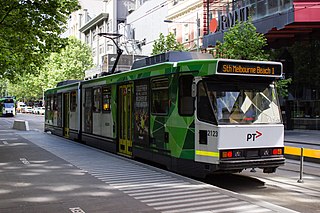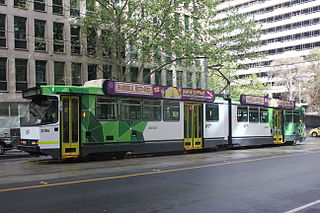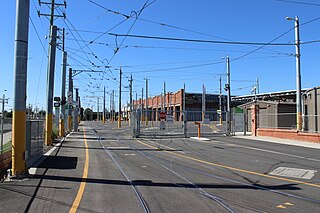
Southbank is an inner-city suburb in Melbourne, Victoria, Australia, 1 km south of Melbourne's Central Business District, located within the Cities of Melbourne and Port Phillip local government areas. Southbank recorded a population of 22,631 at the 2021 census.

Yarra Trams is the trading name of the operator of the tram network in Melbourne, Australia, which is owned by VicTrack and leased to Yarra Trams by the Victorian Department of Transport. The current franchise is operated by Keolis Downer. As at May 2014, Yarra Trams operate 487 trams, across 26 tram routes and a free City Circle tourist tram, over 1,763 tram stops. With 250 km (155.3 mi) of double track, Melbourne's tram network is the largest in the world.

Melbourne tram route 96 is operated by Yarra Trams on the Melbourne tram network from Brunswick East to St Kilda Beach. The 13.9 kilometre route is operated out of Southbank depot with C2 and E class trams.

Melbourne tram route 75 is operated by Yarra Trams on the Melbourne tram network from Vermont South to Central Pier. The 22.8 kilometre route is operated out of Camberwell depot with A and B class trams. It is the longest route on the network.

Melbourne tram route 109 is operated by Yarra Trams on the Melbourne tram network from Box Hill to Port Melbourne. The 19.3 kilometre route is operated out of Kew depot with A and C class trams.

The Sandridge Bridge is a historic bridge, originally carrying a railway, over the Yarra River in Melbourne, Victoria, Australia. It runs diagonally to the river's banks and is 178.4 metres (585 ft) long. In 2006 it was redeveloped as a pedestrian and cycle path featuring public art. It is the third bridge on the site and is listed on the Victorian Heritage Register.

Melbourne tram route 16 is operated by Yarra Trams on the Melbourne tram network from Melbourne University to Kew. The 20.2 kilometre route is operated out of Malvern depot with Z and D1 class trams.

The Colonial Tramcar Restaurant was a restaurant operating from a converted fleet of three vintage W class trams in Melbourne, Australia from 1982 until 2018.

The A-class Melbourne tram is a class of bogie trams that operate on the Melbourne tram network. Seventy were built by Comeng, Dandenong between 1984 and 1987 in two batches, 28 A1's and 42 A2's, with only minor differences. They are the smallest trams by capacity currently operating on the network.

Melbourne tram route 1 is operated by Yarra Trams on the Melbourne tram network from East Coburg to South Melbourne Beach. The 13.2-kilometre (8.2 mi) route is operated out of Brunswick depot with Z and B class trams.

Southbank tram depot is located in Southbank, a suburb of Melbourne, Australia. Operated by Yarra Trams, it is one of eight tram depots on the Melbourne tram network.

Melbourne tram route 3 is operated by Yarra Trams on the Melbourne tram network from Melbourne University to Malvern East. The 14.9-kilometre (9.3 mi) route is operated out of Glenhuntly depot with Z and B class trams. On weekends route 3 operates as route 3a and diverts via St Kilda Beach.

The B-class Melbourne tram is a class of two-section, three-bogie articulated class trams that operate on the Melbourne tram network. Following the introduction of two B1-class prototype trams in 1984 and 1985, a total of 130 B2-class trams were built by Comeng, Dandenong.

Think Tram was a Victorian Government program aimed at improving Melbourne's tram network. The intended benefits were reduced travel time and better reliability, and better accessibility. The program was run by VicRoads, in partnership with Yarra Trams and Public Transport Victoria. The program targets individual routes or streets with a mixture of different treatments, including the sometimes controversial superstops.

The W-class trams are a family of electric trams built by the Melbourne & Metropolitan Tramways Board (MMTB) between 1923 and 1956. Over the 33 years of production, 752 vehicles spanning 12 sub-classes were constructed, the majority at the MMTB's Preston Workshops.

Preston Workshops is the heavy maintenance facility for the Melbourne tram network. The workshop is located on a block surrounded by Miller Street, St George's Road, Oakover Road and the Mernda railway line in Preston, a suburb of Melbourne, Australia. Following a major redevelopment in April 2016, it also became an operational depot under the name New Preston Depot, taking over from East Preston.

Domain Interchange was a major interchange on the Melbourne tram system. It featured two island platforms with four tracks, and had dedicated turning tracks and through tracks. It was located on St Kilda Road between Domain Road and Park Street, adjacent to Kings Domain, and was one of the busiest interchanges on the system, being used by eight tram routes. The most recent structure was opened in April 2013, replacing an earlier structure built in 1986.

Melbourne tram route 12 is operated by Yarra Trams on the Melbourne tram network from Victoria Gardens Shopping Centre to St Kilda. The 16.2-kilometre (10.1 mi) is operated out of Southbank depot with A class trams.

St Vincent's Plaza is a major interchange of the Melbourne tram network, serviced by Yarra Trams routes 11, 12, 30 and 109. It is located in the wide centre median of Victoria Parade, wedged between the intersections of Gisborne Street and Brunswick Street.
The Melbourne tram network began in 1884 with the construction of the Fairfield Horse Tramway. However, the purpose of the line was to increase land prices in the area, and it soon closed during the depression in 1890. The first genuine attempt to construct a tramway network was the construction of the Richmond cable tram line by the Melbourne Tramway & Omnibus Company in 1885. Over the next few years, 16 more cable tram lines were constructed, as well as numerous other horse tramways. The depression of the early 1890s slowed further expansion of the cable network. The first electric tram line was the Box Hill and Doncaster tramway which opened in 1889. This was a pioneering line in what was then the countryside and thus didn't receive much patronage. It closed in 1896. The next attempt at an electric tramway was Victorian Railways' St Kilda to Brighton line, which opened in 1906. Later that year, the North Melbourne Electric Tramway & Lighting Company opened lines to Essendon and Maribyrnong. Many local councils formed their own tramway trusts and built tramways within their own constituency. The most successful of these was the Prahran & Malvern Tramways Trust.

















